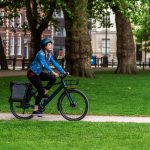The popularity of cycling has exploded in recent years, which means more of us than ever are taking to two wheels for the first time or returning to them after a long period away. If you’re a new or returning cyclist, then have a read of our top cycling goals for beginners to get you prepared for the journey ahead.
Identify what cycling you want to do
We’ve put this at the top of the list because it really is the most important goal to define upfront. It could be that you want to explore your local area while cycling. Or perhaps shift a few pounds and tone up your muscles. Or enjoy the thrill of flying up and down hills as quickly as possible.
Find a particular aspect to enjoy within cycling – something that you’ll really commit to doing on a regular basis – and it will help you stick to your new regime and turn what could become a bit of a chore into something you actively want to do.
The right cycling accessories
If you’re reading an article about the best cycling goals for beginners, we’re going to assume you already have your bike sorted (if not, just head on over to Halfords for all the latest models!). But what about bike accessories?
Here are the ones we reckon every cycling starter pack should include:
It’s also worth having a think about cycling clothing. While a full-on cycling outfit might seem a bit excessive when you’re just starting out, investing in a jersey or padded shorts can really bring extra comfort to your ride.
Work regular cycling time into your schedule
This ties nicely in with our first point about motivation and sticking to what you’ve started. If you carve out a regular daily, every-other-daily or weekly slot in your calendar for some two-wheeled time, then you’ll be able to give your new cycling adventure the attention it deserves.
It will help you to get into a routine that you can follow, as cycling will begin to feel like just another part of your life. Regular sessions will also give you an easy way to track your progress if you’re working towards any specific aims like weight loss or increasing your endurance.
Build up slowly and steadily
Setting yourself a challenge can be a great source of motivation, but don’t try to do too much too soon. You need to give yourself (and your muscles!) the chance to adjust to the rigors of cycling before piling on the pressure. Practice makes perfect, as they say.
Start small and work up from there. If you cycle for 20 minutes the first week, cycle for 25 the next and then 30 the week after. If you managed 5 kilometres on your first outing, aim for 6 the next time around. Define a simple training plan that sees you increase your progress by small increments and it really won’t be long until you start seeing (and feeling) the difference.
And don’t beat yourself up if you can’t reach your goal and find you have to adjust your expectations. We all have those days when our bodies just refuse to cooperate, no matter what our heads are saying we should be able to do. So cut yourself some slack, do as much as you can on the day and then try again next time!
Track your progress
We briefly mentioned manually tracking your progress earlier, but you can also get some help with that – and a whole lot more.
Cycling apps have become all the rage over the last several years and can do everything from tracking your progress to suggesting cycle routes to allowing you to share data with friends.
Here’s a quick rundown of some of the most popular:
- Strava: Strava’s probably the best-known cycling app on the market and excels at ride tracking as well as the more social side of cycling. There’s a free version and also a paid subscription model that unlocks more features.
- Komoot: Komoot is the top pick for route planning and boasts a sophisticated system where you can choose your route based on a variety of criteria. Like Strava, there’s a free version with limited features and a paid premium version.
- TrainingPeaks: TrainingPeaks is dedicated to tracking your fitness levels and so all its features centre around this premise. You can create and schedule workouts or choose training plans from top coaches. As with the others, there’s a free version and a premium one to choose from.
- Zwift: Zwift has cornered the market on indoor training over the last couple of years (for obvious reasons). You’ll need a turbo trainer to get you started and check out our blog for all the ins and outs of this app.
Sometimes, half the fun of cycling is planning where you’re going to travel and that’s where our article on Cycle route planning for beginners comes in. Find out how to plan the perfect route no matter what your requirements are.
One final thing – if you’re looking to ride your bike to work, be sure to check out the Cycle2Work scheme. Cycle2Work is a government initiative, allowing you to get a new bike and accessories for less. The reduced cost is simply deducted from your payslip over 12 or 18 months. You can even access promotional and seasonal offers such as Christmas and Black Friday on top of Cycle2Work savings!
Whatever your level of cycling you’re at, you can always trust Halfords to support you on your journey.


